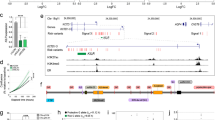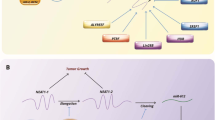Abstract
Background
Long non-coding RNAs (lncRNAs) govern fundamental biochemical and cellular biology processes, for example, participate in chromatin remodeling, imprinting, splicing, transcriptional regulation and translation. Dysregulation of lncRNA expression is act as a feature of various diseases and cancers, including hematopoietic malignancies. However, the clinical relevance of myelodysplastic syndrome (MDS) and acute myeloid leukemia preceded by MDS (MDS-AML) requires further research. Recently, lncRNAs have been demonstrated, which play an important role in hematopoiesis, thus, to further finding more functional lncRNA seemed particularly important.
Methods
Western blotting, real-time PCR, RNA-pulldown, RIP (RNA immunoprecipitation), Chromatin immunoprecipitation (ChIP), cellular compartments extraction assays, SA-β-gal staining, lentivirus transfection, cell viability assay and cell proliferation assays were used to examine the relationship between lncRNA LINC01255 and its regulation of p53–p21 pathway in human mesenchymal stromal and acute myeloid leukemia cells.
Results
LncRNA LINC01255 is highly expressed in bone marrow cells of AML patients, CD34+ cells of MDS-AML patients and AML cell lines and the higher expression of LINC01255 is associated with poor survival rate of AML patients. LINC01255 can interact with BMI1 and repress the transcription of MCP-1 to active p53–p21 pathway, thus inhibiting the senescence of human mesenchymal stromal and proliferation of acute myeloid leukemia cell.
Conclusions
We discovered a novel functional lncRNA LINC01255, which can regulate the senescence of human mesenchymal stromal and the proliferation of acute myeloid leukemia cell through inhibiting the transcription of MCP-1.





Similar content being viewed by others
Data availability
All relevant data are available from the authors on request.
Abbreviations
- MDS:
-
Myelodysplastic syndromes
- AML:
-
Acute myeloid leukemia
- IPSS:
-
International prognostic scoring system
- IPSS-R:
-
International prognostic scoring system (IPSS) the revised IPSS
- ELN:
-
European Leukemia Net
- ncRNAs:
-
Non-coding RNAs
- miRNAs:
-
MicroRNAs
- piRNAs:
-
PIWI-interacting RNAs
- siRNAs:
-
Small interfering RNA
- snRNAs:
-
Small nuclear RNAs
- snoRNAs:
-
Small nucleolar RNAs
- lncRNAs:
-
Long non-coding RNAs
- BMI1:
-
B Lymphoma Mo-MLV Insertion Region 1
- UCB-MSCs:
-
Umbilical cord blood-derived MSCs
- RIP:
-
RNA immunoprecipitation
- SASP:
-
Senescence-associated secretory phenotype
- MSC:
-
Human mesenchymal stromal cells
References
Arber DA, et al. The 2016 revision to the World Health Organization classification of myeloid neoplasms and acute leukemia. Blood. 2016;127:2391–405.
Zhao X, et al. An integrated regulatory network based on comprehensive analysis of mRNA expression, gene methylation and expression of long non-coding RNAs (lncRNAs) in myelodysplastic syndromes. Front Oncol. 2019;9:200.
Huang HH, et al. Long non-coding RNA HOXB-AS3 promotes myeloid cell proliferation and its higher expression is an adverse prognostic marker in patients with acute myeloid leukemia and myelodysplastic syndrome. BMC Cancer. 2019;19:617.
Larsson CA, Cote G, Quintas-Cardama A. The changing mutational landscape of acute myeloid leukemia and myelodysplastic syndrome. Mol Cancer Res. 2013;11:815–27.
Zeidan AM, et al. Disease-related costs of care and survival among medicare-enrolled patients with myelodysplastic syndromes. Cancer. 2016;122:1598–607.
Greenberg P, et al. International scoring system for evaluating prognosis in myelodysplastic syndromes. Blood. 1997;89:2079–88.
Voso MT, et al. Revised International Prognostic Scoring System (IPSS) predicts survival and leukemic evolution of myelodysplastic syndromes significantly better than IPSS and WHO Prognostic Scoring System: validation by the Gruppo Romano Mielodisplasie Italian Regional Database. J Clin Oncol. 2013;31:2671–7.
Della Porta MG, et al. Validation of WHO classification-based Prognostic Scoring System (WPSS) for myelodysplastic syndromes and comparison with the revised International Prognostic Scoring System (IPSS-R). A study of the International Working Group for Prognosis in Myelodysplasia (IWG-PM). Leukemia. 2015;29:1502–13.
de Swart L, et al. Validation of the revised international prognostic scoring system (IPSS-R) in patients with lower-risk myelodysplastic syndromes: a report from the prospective European LeukaemiaNet MDS (EUMDS) registry. Br J Haematol. 2015;170:372–83.
Dohner H, et al. Diagnosis and management of AML in adults: 2017 ELN recommendations from an international expert panel. Blood. 2017;129:424–47.
Estey E. Acute myeloid leukemia: 2016 update on risk-stratification and management. Am J Hematol. 2016;91:824–46.
Hou HA, et al. Incorporation of mutations in five genes in the revised International Prognostic Scoring System can improve risk stratification in the patients with myelodysplastic syndrome. Blood Cancer J. 2018;8:39.
Alhan C, et al. The myelodysplastic syndromes flow cytometric score: a three-parameter prognostic flow cytometric scoring system. Leukemia. 2016;30:658–65.
Hainer SJ, et al. Suppression of pervasive noncoding transcription in embryonic stem cells by esBAF. Genes Dev. 2015;29:362–78.
Spornraft M, Kirchner B, Pfaffl MW, Riedmaier I. Comparison of the miRNome and piRNome of bovine blood and plasma by small RNA sequencing. Biotechnol Lett. 2015;37:1165–76.
Fatica A, Bozzoni I. Long non-coding RNAs: new players in cell differentiation and development. Nat Rev Genet. 2014;15:7–21.
Kung JT, Colognori D, Lee JT. Long noncoding RNAs: past, present, and future. Genetics. 2013;193:651–69.
Zhang X, et al. A myelopoiesis-associated regulatory intergenic noncoding RNA transcript within the human HOXA cluster. Blood. 2009;113:2526–34.
Zeng C, et al. Inhibition of long non-coding RNA NEAT1 impairs myeloid differentiation in acute promyelocytic leukemia cells. BMC Cancer. 2014;14:693.
Yildirim E, et al. Xist RNA is a potent suppressor of hematologic cancer in mice. Cell. 2013;152:727–42.
Rodriguez-Malave NI, Rao DS. Long noncoding RNAs in hematopoietic malignancies. Brief Funct Genomics. 2016;15:227–38.
Zhang X, et al. Maternally expressed gene 3 (MEG3) noncoding ribonucleic acid: isoform structure, expression, and functions. Endocrinology. 2010;151:939–47.
You D, et al. MicroRNA-498 inhibits the proliferation, migration and invasion of gastric cancer through targeting BMI-1 and suppressing AKT pathway. Hum Cell. 2020;33:366–76.
Zhang S, et al. LncRNA NR2F2-AS1 promotes tumourigenesis through modulating BMI1 expression by targeting miR-320b in non-small cell lung cancer. J Cell Mol Med. 2019;23:2001–11.
Fang J, et al. LncRNA CASC9 suppressed the apoptosis of gastric cancer cells through regulating BMI1. Pathol Oncol Res 2020;26:475–482. https://doi.org/10.1007/s12253-019-00703-3.
Liu G, et al. LncRNA ZFAS1 promotes growth and metastasis by regulating BMI1 and ZEB2 in osteosarcoma. Am J Cancer Res. 2017;7:1450–62.
Mihara K, et al. Bmi-1 is useful as a novel molecular marker for predicting progression of myelodysplastic syndrome and patient prognosis. Blood. 2006;107:305–8.
Petrov VN, et al. In Vivo effects of human bone marrow mesenchymal stromal cells on the development of experimental B16 melanoma in mice. Bull Exp Biol Med 2020;168:561–565. https://doi.org/10.1007/s10517-020-04753-5.
Gomez-Barrena E, et al. Early efficacy evaluation of mesenchymal stromal cells (MSC) combined to biomaterials to treat long bone non-unions. Injury 2020;1:S63-S73. https://doi.org/10.1016/j.injury.2020.02.070.
Yagura K, et al. The enhancement of CCL2 and CCL5 by human bone marrow-derived mesenchymal stem/stromal cells might contribute to inflammatory suppression and axonal extension after spinal cord injury. PLoS ONE. 2020;15:e0230080.
Simon MD, et al. The genomic binding sites of a noncoding RNA. Proc Natl Acad Sci USA 2011;108:20497–20502.
Shang Z, et al. USP9X-mediated deubiquitination of B-cell CLL/lymphoma 9 potentiates Wnt signaling and promotes breast carcinogenesis. J Biol Chem. 2019;294:9844–57.
Zhang H, et al. Differential gene regulation by the SRC family of coactivators. Genes Dev. 2004;18:1753–65.
Khawar MB, Mehmood R, Abbasi MH, Sheikh N. Multifactorial role of long non-coding RNAs (LncRNAs) in hematopoiesis. Front Biosci (Schol Ed). 2018;10:119–26.
Cheng H, et al. Microarray profiling and co-expression network analysis of the lncRNAs and mRNAs associated with acute leukemia in adults. Mol BioSyst. 2017;13:1102–8.
Bracken AP, et al. The Polycomb group proteins bind throughout the INK4A-ARF locus and are disassociated in senescent cells. Genes Dev. 2007;21:525–30.
Molofsky AV, et al. Bmi-1 dependence distinguishes neural stem cell self-renewal from progenitor proliferation. Nature. 2003;425:962–7.
Jin HJ, et al. Senescence-associated MCP-1 secretion is dependent on a decline in BMI1 in human mesenchymal stromal cells. Antioxid Redox Signal. 2016;24:471–85.
Rizo A, et al. Repression of BMI1 in normal and leukemic human CD34(+) cells impairs self-renewal and induces apoptosis. Blood. 2009;114:1498–505.
El-Sharnouby S, Redhouse J, White RA. Genome-wide and cell-specific epigenetic analysis challenges the role of polycomb in drosophila spermatogenesis. PLoS Genet. 2013;9:e1003842.
Oguro H, et al. Differential impact of Ink4a and Arf on hematopoietic stem cells and their bone marrow microenvironment in Bmi1-deficient mice. J Exp Med. 2006;203:2247–53.
Ganau M, et al. How nanotechnology and biomedical engineering are supporting the identification of predictive biomarkers in Neuro-Oncology. Med Basel 2018;26;5:23. https://doi.org/10.3390/medicines5010023.
Merle M, et al. Serum Chemokine-release profiles in AML-patients might contribute to predict the clinical course of the disease. Immunol Invest 2020;49:365–385. https://doi.org/10.1080/08820139.2019.1661429.
Yoshimura T. The production of monocyte chemoattractant protein-1 (MCP-1)/CCL2 in tumor microenvironments. Cytokine. 2017;98:71–8.
Li X, et al. A destructive cascade mediated by CCL2 facilitates prostate cancer growth in bone. Cancer Res. 2009;69:1685–92.
Fujimoto H, et al. Stromal MCP-1 in mammary tumors induces tumor-associated macrophage infiltration and contributes to tumor progression. Int J Cancer. 2009;125:1276–84.
Kitamura T, et al. CCL2-induced chemokine cascade promotes breast cancer metastasis by enhancing retention of metastasis-associated macrophages. J Exp Med. 2015;212:1043–59.
Wiseman BS, Werb Z. Stromal effects on mammary gland development and breast cancer. Science (New York, N.Y.). 2002;296:1046–9.
Funding
This study was supported by Medical and Health Science and Technology Development Project of Shandong (2018WS122), Science and Technology Development Plan (guidance plan) of Taian (2018NS0123), 2019–2020 Chinese Medicine Science and Technology Development Project of Shandong (2019–0343).
Author information
Authors and Affiliations
Contributions
HZ conceived this project; QL, HZ, JD, JL, YD, KW and QK conducted experiments; QL and HZ acquired and analysed data; HZ wrote the manuscript.
Corresponding author
Ethics declarations
Conflicts of interest
The authors have declared that no conflict of interest exists.
Ethics approval and Informed consent
Ethics approval and consent files and Subject Informed Consent Certification file were offered in supplemental files.
Research involving human participants and/or animals
This article does not contain any studies with animals performed by any of the authors.
Additional information
Publisher's Note
Springer Nature remains neutral with regard to jurisdictional claims in published maps and institutional affiliations.
Electronic supplementary material
Below is the link to the electronic supplementary material.
Rights and permissions
About this article
Cite this article
Liu, Q., Dong, J., Li, J. et al. LINC01255 combined with BMI1 to regulate human mesenchymal stromal senescence and acute myeloid leukemia cell proliferation through repressing transcription of MCP-1. Clin Transl Oncol 23, 1105–1116 (2021). https://doi.org/10.1007/s12094-020-02505-5
Received:
Accepted:
Published:
Issue Date:
DOI: https://doi.org/10.1007/s12094-020-02505-5




